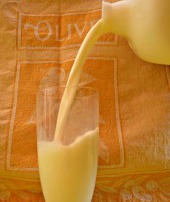Lactose Intolerance Must-Knows
Lactose intolerance is the most common form of food intolerance.
Food intolerance is NOT an allergic condition. Food allergies and food hypersensitivities deal with adverse reaction to proteins and chemicals. Food intolerance is about enzyme shortage. Visit Food Allergies section to better understand the difference.
Intolerance refers solely to foods. It is a very common condition. Our body digests with the help of enzymes. Shortage of one of the enzymes prevents the foods from proper breaking down.
Here is a list of food intolerance symptoms:
- Diarrhea
- Cramping
- Boating
- Nausea
- Abdominal pain after meal
- Diagnosed gastroenteritis
- Blood or mucous in the stool
Is Lactose Intolerance Different From Milk Allergy?
Lactose intolerance is caused by the shortage of enzyme lactase. Lactase helps digesting dairy sugar lactose. The baby may be born with lactase deficiency or may acquire it later in life.
It is rarely caused by human milk. If this condition happens in breastfed babies, it is mostly due to mom’s dairy intake.
As we grow older, our body’s ability to produce lactase weakens and leads to intolerance. Decreasing dairy intake should keep it under control.
Milk allergy is an inability of the body to digest milk proteins. Visit Milk Allergy section to read more.
"False" Intolerance
Sometimes a temporary lactase deficiency occurs. It may happen if your baby has diarrhea for several days. A lot of lactase is washed out of the body. Lactase level goes back to normal once diarrhea is gone.
Another instance of “false” lactase deficiency occurs if the mom is suffering from excessive breast milk oversupply – the so-called lactose “overdose”.
When the baby starts sucking, low-fat foremilk comes first. Heavier calorie-rich hindmilk follows. In women with overabundant milk supply, the baby has to suck for a long time to reach the hindmilk.
If the hindmilk is not reached, more milk is produced and the hindmilk is moved to the back again. Next feeding starts with the foremilk.
The amount of lactose in fore- and hindmilk is the same. However, fat in the hindmilk slows down digestion and allows enough time for lactase to digest the lactose. If the foremilk/hindmilk balance is off, the body is getting lots of lactose and no fat. The lactose rushes through the intestines without proper digestion.
Undigested lactose that reaches large intestine, ferments there and irritates it. This causes gassiness, greenish, mucousy or bloody stool, cramping and boating.
Bloody stool is also a sign of food allergies. But if there are symptoms of oversupply, it is most likely the reason (not the allergies) for blood in your baby’s stool.
This “false” lactase deficiency is treated by getting the milk supply under control. Here is how.
What to Do
The only treatment for true lactose intolerance is limiting or avoiding the triggers. Try limitation first. Your baby maybe able to safely digest a little bit of lactose.
Elimination diet will be your next step. It is when a mother eliminates all the potential allergens from her diet. After the symptoms go away, the foods are re-introduced one by one. Allow a two-week interval between new foods.
Rotation diet is when a mother eats every food only once
every 5-6 days. By the end of this time there should be a reaction to an
allergen, if any.
If your baby develops serious intolerance symptoms (blood in the stool), completely eliminate lactose from your and your baby’s diet. It may take up to a month or even longer before lactose completely clears from your systems. Read my story here.
If you have a family history of food intolerance and your baby shows signs, strict avoidance can prevent future allergies. If you keep your baby safe at least until he/she is 12 months old, he/she may outgrow it altogether and never have to suffer.
There are many ways to show your love and devotion to your kids and to win their trust. Breastfeeding is the most natural one.
Yours,
Viktoriya
Back to top of Lactose Intolerance>Food Allergies>Breastfeeding Home











